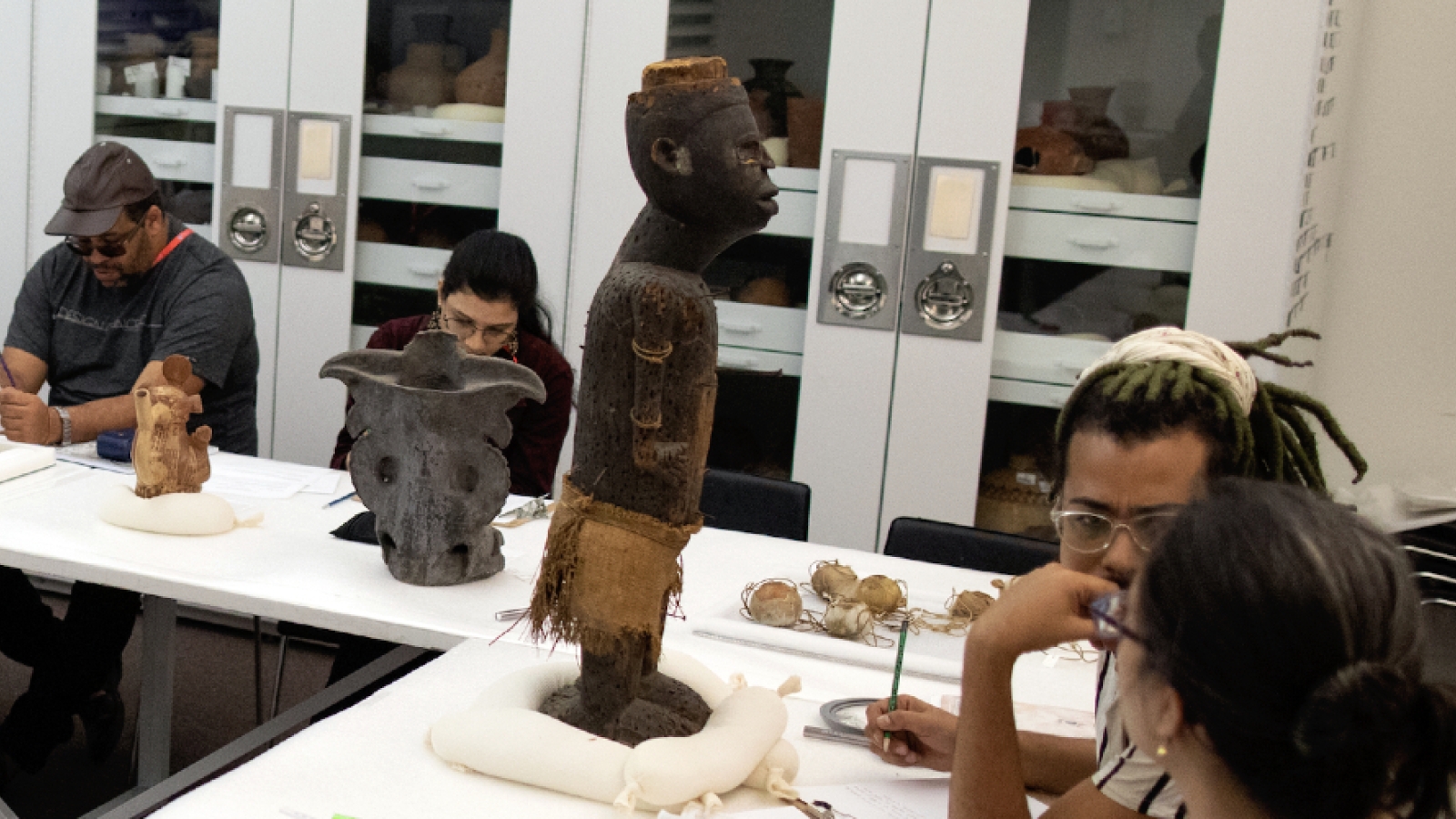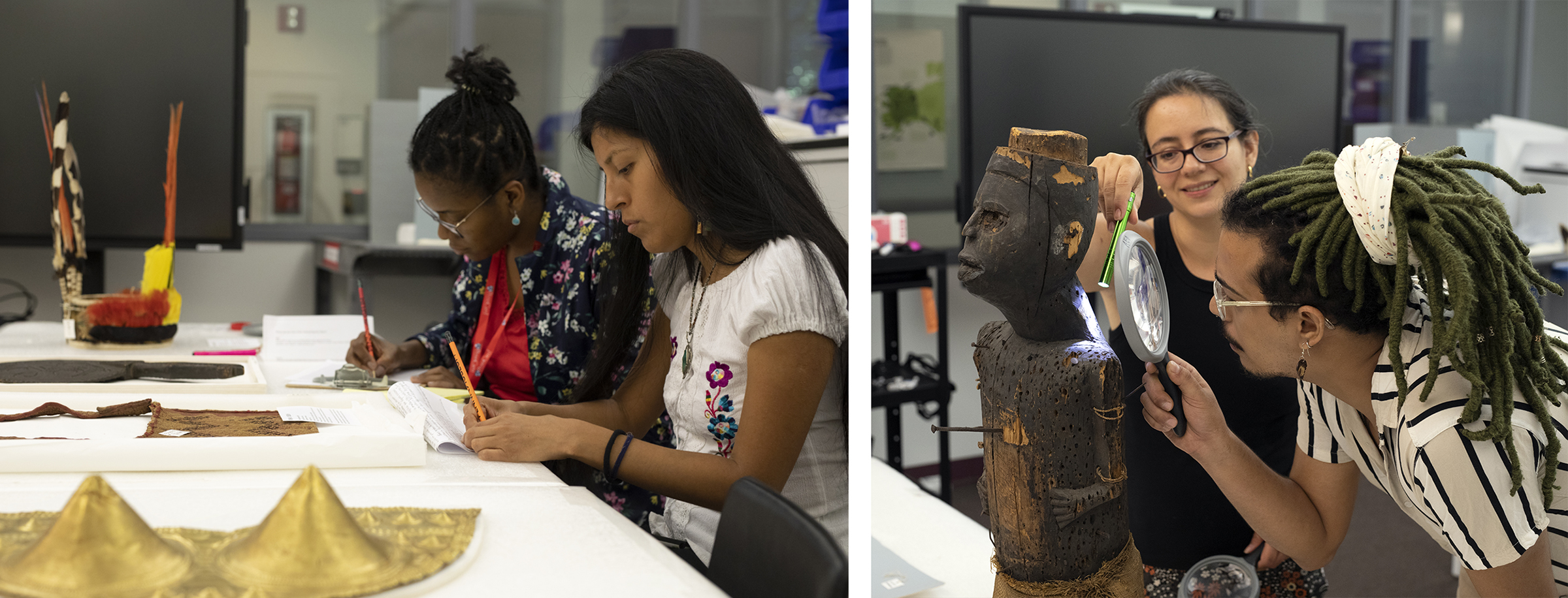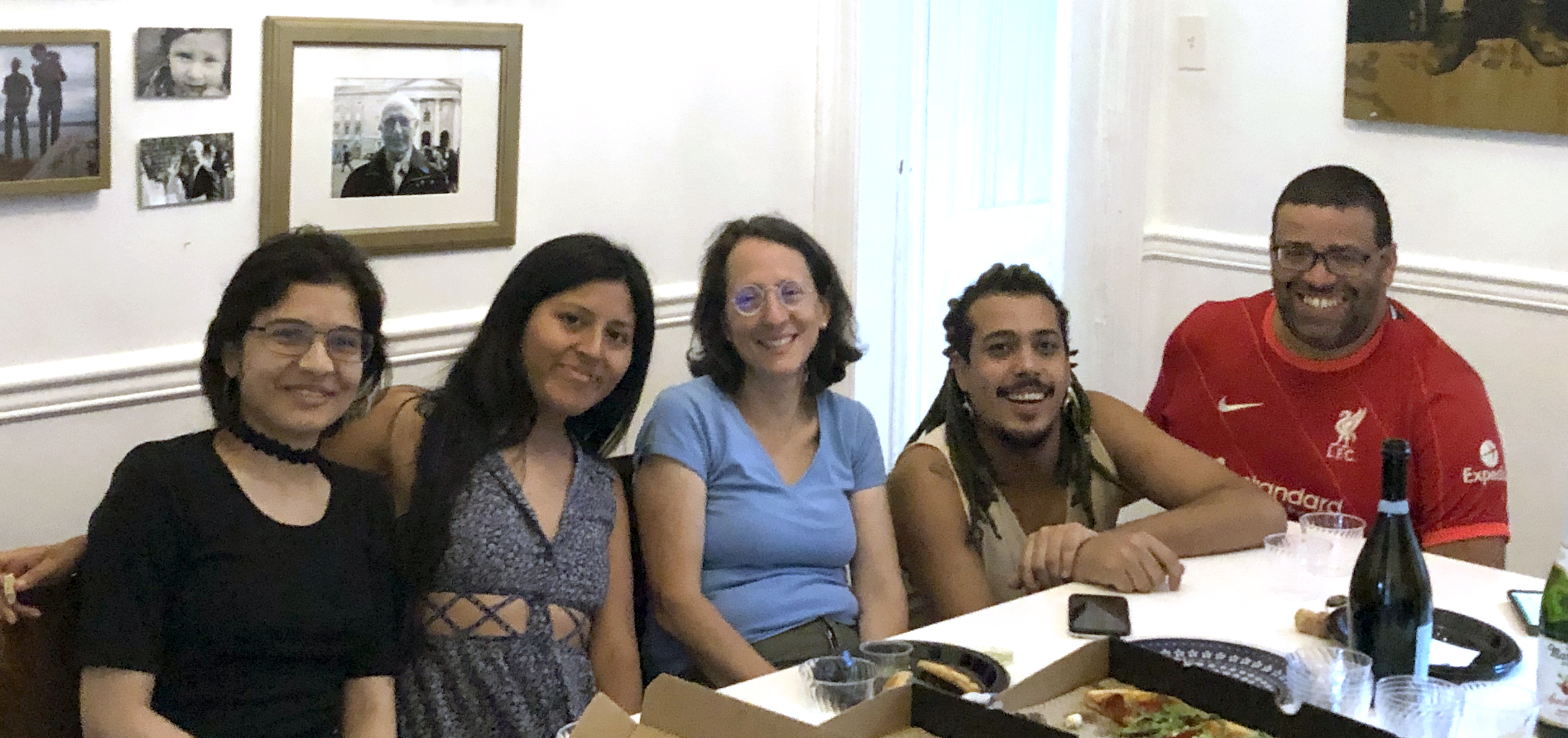The Center for Latin American and Latinx Studies (CLALS), an interdisciplinary research and teaching center for the study of Latin America and Latinx populations, seeks to provide the human and intellectual capital capable of addressing the most pressing challenges and opportunities during the 21st century. The center recently hosted the Symposium Ethnohistory Workshop: Dispossessions in the Americas. Ann Farnsworth-Alvear, Associate Professor of History, spearheaded and organized this three-week workshop for young scholars from Latin America, many who identify as Indigenous or Afro-descendant. It was designed to hone ethnohistorical and oral history skills. The scholars attended workshops and lectures by CLALS-affiliated faculty. They visited historical archives of the Van Pelt Library and other libraries in the Philadelphia region, as well as the resources of the Penn Museum. The workshop was funded by the Mellon Dispossessions in the Americas grant. Below, read accounts from the young scholars about their time at the workshop.
Silva Whodson
What is your field of study?
I’m an anthropologist. I’m currently pursuing a Ph.D. in social anthropology in Brazil. I study socio-environmental conflicts between Indigenous and Black communities on the one hand, and infrastructural megaprojects that are being developed in their traditional territories on the other.
What research had you done prior to your visit?
I have worked with Indigenous and Black communities in the Northeast region of Brazil, with their anti-nuclear mobilizations against the construction of new nuclear plants. I also did an internship at the Universidad de Antioquia in Colombia. There, I was able to study the social cartography of San Basilio de Palenque [in the Colombian Caribbean] and water disputes in an indigenous community in Riosucio, briefly.
What were your first impressions of campus?
I was amazed and very pleased with the campus, the resources, and the infrastructure of the University. There is a massive gap between Latin American and U.S. universities; it is very palpable and shocking. This experience has made me wonder about the material and symbolic constructions of what we consider the “first” and “third” worlds; it is outrageous.
What did you hope to gain from the workshop?
Expand my mind, contribute to my personal development and professional career, and continue growing a network of important contacts for my career. Also, getting to know other Latin American scholars to share experiences. The whole experience during this workshop was terrific.
What workshop sessions really spoke to you?
I enjoyed the campus tour; it was an opportunity to get to know different locations so we could have the autonomy to seek what we were looking for. Also, the activity with museum objects was very enriching; I learned a lot from working with a Nkisi from Angola, held by the Penn Museum: it was fascinating! There was also a workshop on digital resources, mapping, archives, and other tools that are very useful for our research work back in our countries. The presentations by researchers and visiting scholars were also essential to reflect on the connections between the dispossessions and acts of violence upon the bodies and territories in Latin America.
What was the experience at Van Pelt Library like? Highlights? Anything unexpected?
It was important to access Van Pelt Library, its collection, and different spaces internal to the library. For me, it was also an excellent opportunity to have access through PennKey to the virtual services of the library; it is simply spectacular. In my country, I often have trouble accessing websites, scholarly articles, and other materials that here are available just with a PennKey. So it was fantastic to access the sources available in the library, both physical and virtual.
The Digital Media Lab at Van Pelt Library was wonderful! We had access to equipment that allowed us to document important issues and facts for our research. For example, I had the opportunity—with the help of professor Ann Farnsworth and activist Sally Willowbee—to visit Three Mile Island, the location of the most severe nuclear accident in the U.S. There, I did some audio and visual recordings [with the equipment borrowed from the library] that will be very useful for my Ph.D. dissertation.
What was the experience at Penn Museum like? Highlights? Anything unexpected?
The experience at the museum was extraordinary. I visited the Musuem library; it was terrific as a place to study. Seeing the different galleries of the museum was also very special. I was able to visit the African galleries with a guided tour by Brazilian professor Vanicleia Silva Santos; it was fascinating for me as an anthropologist and, especially, as a young Afro-Brazilian. The exercise with the museum’s object was very constructive and productive, too.
What was your biggest takeaway from the workshop overall? How might it impact your future research?
I’ve learned about life and expanded my horizon of ideas and possibilities. I was fascinated by new and unimaginable things. It is interesting to get to know another university, in another country, with another culture, through a program that facilitates comfortable and privileged academic training and professional development. I feel delighted and motivated to continue contributing to my country.

Kelly Johanna López Roldán
What is your field of study?
I’m a historian and sociologist with a master’s in history.
What research had you undertaken before your visit?
I study the chronicles and natural histories of the 16th and 17th centuries. Through Europeans’ descriptions of nature in the Americas, I work to disentangle the appropriations and conflicts that took place as a colonial society was established. For example, some stimulants and psychoactive plants—such as tobacco, yopo, coca, and peyote—generated debates among the Catholic Church and civil authorities. These led to periods when the consumption of these plants was prohibited, especially among Indigenous people, because Spaniards considered their use evidence of the continuation of idolatry.
What were your first impressions of campus?
The campus is lovely. Perhaps the most important thing for me was to see how it connects with the surrounding neighborhoods. In my city, universities still debate whether to maintain security barriers or to opt for open campuses. I think that it is crucial that universities be public spaces where anyone can walk.
What did you hope to gain from the workshop?
To me, it was important to get to know the work of other Latin-American researchers. The workshop was, therefore, a chance to overcome disciplinary and geographical barriers. I’m convinced that tearing down those obstacles fosters new questions and perspectives that help address different research problems.
What workshop sessions really spoke to you?
I was excited to meet professor Marcy Norton because her work has been an inspiration for me for a long time. Furthermore, the workshop on paleography inspired me to improve my ability to read and understand the handwriting of the centuries that I study, to be able to analyze other types of sources [like judicial processes, wills, land records]. Lastly, I must admit that the presentation by Amber Henry moved me. I hope never to lose my passion for the things I do and be able to convey it to others.
What was the experience at Van Pelt Library like? Highlights? Anything unexpected?
I can say two things to decribe Van Pelt library: abundance and generosity. There are six floors full of books; you need a navigation chart and some skills to find what you are looking for. In Colombia, access to the latest publications is limited, especially if it is in a language other than Spanish. It was a shame that in the summer Van Pelt is only open until 6 p.m. Otherwise, I wouldn’t have been able to leave it. I didn’t expect to be able to enter special collections and the Henry Charles Lea reading room, which were amazing. I’m very grateful to John Pollack, curator of research services, who, far from the hermit-like spirit of some librarians, allowed us to examine books published more than 400 years ago without distrusting us.
What was the experience at Penn Museum like? Highlights? Anything unexpected?
Being able to see an effigy of a warrior dressed as a jaguar from the Moche culture and a series of recipients that the Huichol used to carry tobacco during their peyote peregrinations was captivating. Having the chance to observe them closely and from different angles, measure and weigh them, for me, was like experiencing something secret, a mixture between childish joy and the solemnity of the believer. I would also highlight the tour of the Africa Galleries with professor Vanicleia Silva Santos, especially the effort to describe the trajectory of the objects: What is the story behind the objects we see in the museums? Were they stolen, bought, or donated? Who made them? These questions allowed me to question the idea of the museum as an aseptic space and just a “collection of cultures from the world,” and I began looking at it as part of a colonial legacy that is very troubling.
What was your biggest takeaway from the workshop, overall? How might it impact your future research?
The workshop reasserted for me the need to understand that history is a discipline rooted in the present, depending on constant dialogue between scholars and communities. Research is a collective effort that requires continuous listening and learning from others. The study of nature in previous centuries must keep in mind the material culture, beliefs, and practices through which all societies have constructed a relationship with the environment. Hence, it is necessary to borrow perspectives and tools from other disciplines, especially anthropology.
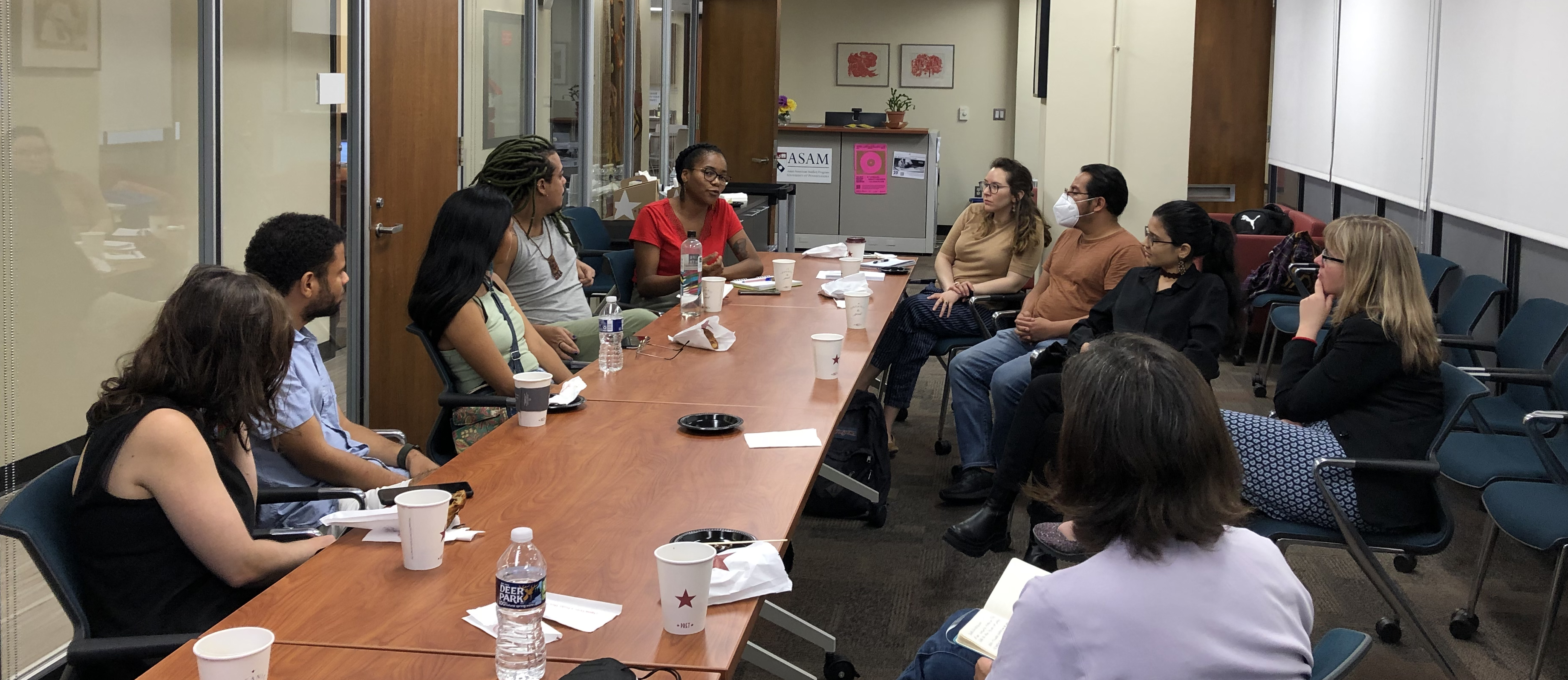
Libia Díaz-Ulabares
What is your field of study?
I studied a Bachelor of Popular Education and another of Foreign Languages at University of Valle in Cali, Colombia. Social sciences have been my field of study, enriching my research with disciplines such as political science, sociology, anthropology and history. Thanks to the degrees that I did and my experience as a Black person being the first one attending college from my ancestral territory Peon, I have focused my research on territorialization, resistance, and land tenure of the Afro-Colombian people with my territory as a case study. Currently, as a student of a master in political and social studies, I am writing my first book with the findings of this research.
What research had you undertaken before your visit?
At the end of my first degree, I did a research project about the process of territorialization led by my Black extended family who had been deracinated from the region north of Cauca and arrived in the Valle del Cauca region in the 19th century. When finishing my second degree I did a research project about the connection of the speech of my community and our identity as Black farmers. In the master in political and social studies, I am analyzing the process of territorialization of my community as an example of the land tenure of Black folks in Colombia. It means I am studying how this Black community achieved to buy some lands in the 20th century as a way to face the historical deracination, and continued implementing strategies of resistance to maintain its ancestral territory.
What were your first impressions of campus?
My first impressions of the Penn Campus were the comfortable layout of pathways and rooms; the variety of spaces to create and recreate knowledge; and the wide range of sources to develop ethnohistorical research.
What did you hope to gain from the workshop?
My expectations with the workshop were to gain ideas about how to strengthen the research that I am doing as a student of the master in political and social studies at University Icesi in Cali with a variety of strategies on ethnohistory research in a global perspective from experiences of Latin America.
What workshop sessions really spoke to you?
The session that really spoke to me was the one by Evelyne Laurent-Perrault, because some preliminary findings of the research that I am doing with the story of my ancestral territory Peon have shown the agency of Black women in the resistance to deracination and the determinant efforts on land tenure of the whole community. And this is a result of the freedom demands of enslaved people, but especially of Black women in the colony as the case presented by Professor Laurent-Perrault. With this section I found how rich is the topic to continue my research with a Ph.D. in history.
What was the experience at Van Pelt Library like? Highlights? Anything unexpected?
The experience at Van Pelt Library was powerful. I loved the Africana Studies Resources Room and the Vitale Digital Media Lab. Finding a studio with equipment to record was something unexpected.
What was the experience at Penn Museum like? Highlights? Anything unexpected?
Penn Museum was one of the most important experiences for me in the workshop. The galleries have a large variety of objects and the one that I loved the most was Ancient Egypt, because I am interested in observing and analyzing why most of the noses of the sculptures are broken. In addition, the exercise with the object was awesome, not only because I could observe in detail the object I chose but also because I learned about the interests of the other scholars.
What was your biggest takeaway from the workshop, overall? How might it impact your future research?
The whole workshop was a huge takeaway. The activities as much as the experience of being in a country of the Global North were meaningful. However one of the most remarkable learning from the workshop was the exercise with the object. It definitely amplified my perspective about the richness of the possible connections that objects have with my research even if they are kilometers far. It made me think about how objects can “tell” stories, link communities, and help people to travel through periods of time. It is relevant to my future research because I can find how objects of the Black women of my territory have been used to resist deracination similar to the study that Professor Amber Henry did with Palenquera women in San Basilio, Colombia.
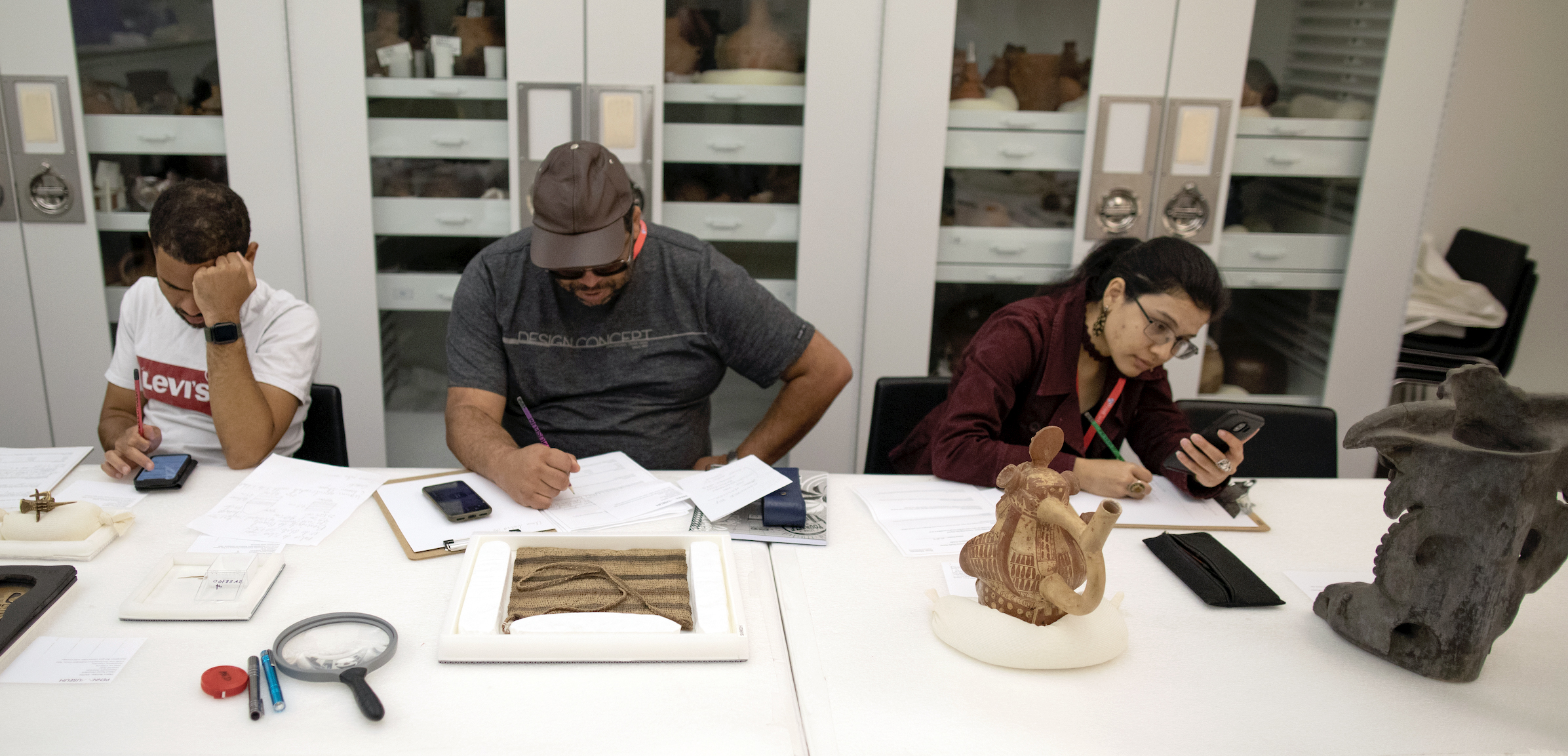
Rayo Cruz
What is your field of study?
I’m a master’s student in applied linguistics at the University of Guadalajara. I focus on the study of the Zapotec language.
What research had you undertaken before your visit?
I research the writings of Zapotec, its development, and its practice throughout history, from the antique Zapotec writing to its practice during the colonial period and even today.
What were your first impressions of campus?
It is quite a nice place to study.
What did you hope to gain from the workshop?
Acquire tools for research in the field of social sciences and humanities.
What workshop sessions really spoke to you?
Mainly the paleography workshop and the presentation by Nancy Farris.
What was the experience at Van Pelt Library like? Highlights? Anything unexpected?
I loved it. The library is impressive, and it has wonderful spaces to work.
What was the experience at Penn Museum like? Highlights? Anything unexpected?
I found valuable objects from Zapotec culture and enjoyed describing them.
What was your biggest takeaway from the workshop overall? How might it impact your future research?
For me, the biggest takeaway was the paleography workshop because part of my research focuses on analyzing colonial sources, and knowing paleography helps read those documents.
Solon Santos
What is your field of study?
I’m a Ph.D. student in the social history program at the Federal University of Bahia, Brazil. My focus is on the history of the Indigenous people of the Sertao in Bahia.
What research had you undertaken before your visit?
I research the Indigenous history of the Sertao da Capitanía of Bahia, known as Sertao das Jacobinas. I analyze the conquest and resistance of the Indigenous groups, like the Payayá.
What were your first impressions of campus?
It is a fantastic space to study, research, and exchange experiences and learnings.
What did you hope to gain from the workshop?
An opportunity to learn, share experiences, a place to research and read.
What workshop sessions really spoke to you?
I enjoyed the session about the material culture at the Penn Museum and the presentation by Professor Roquinaldo Ferreira.
What was the experience at Van Pelt Library like? Highlights? Anything unexpected?
Amazing! I really liked the collection and the search system. Very helpful and attentive service. Excellent reading environment.
What was the experience at Penn Museum like? Highlights? Anything unexpected?
I liked visiting the Penn Museum and exploring part of its collections. Besides, the session about material culture, analyzing a small Tupi bag was fascinating.
What was your biggest takeaway from the workshop, overall? How might it impact your future research?
Learning about paleography and material culture is fundamental for my current research on Indigenous history and future projects on Indigenous historical archaeology.
